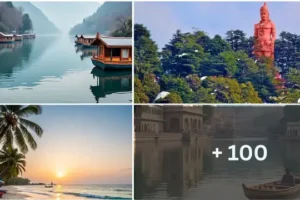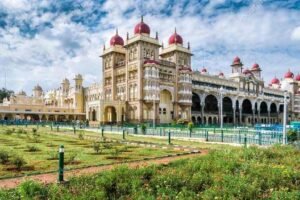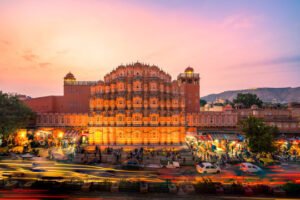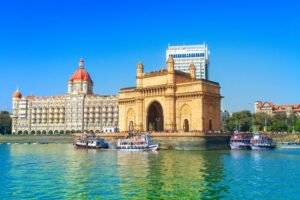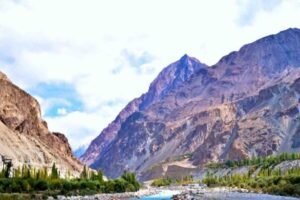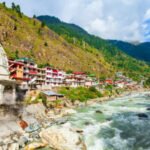Dhuma Devi Temple, The Picnic Hot-Spot, How to Reach Dhuma Devi Temple, Best 5 Places to Visit Nearby
Dhuma Devi Temple: The Spiritual Sanctuary:- Dhuma Devi temple is a Hindu temple dedicated to Goddess Dhumavati, located near Majhwar village in Mandi Town, Himachal Pradesh, India. It’s situated amidst scenic hills and offers panoramic views of the surroundings landscape. The temple is built on the hilltop valley with large ground in the yard of the temple perfects for the picnic.
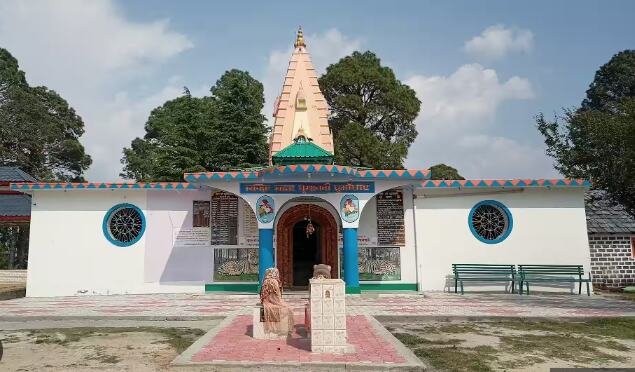
The main deity of the temple is a black stone idol of Goddess Dhumavati. The temple is also known for its beautiful architecture and intricate carvings. The temple is surrounded by lush green hills and forests, making it a peaceful and serene place to visit. The temple is a popular spot for pilgrims and tourists alike. The temple is also known for its annual fair, which is held in the month of April.
The whole area is very beautiful and offer good place to spend time, various local schools and colleges held picnics here, it is also very popular among lovers. A Forest rest house is also available at Dhuandhar.
Dhuma Devi, often associated with the fierce aspect of Goddess Durga, is venerated for her protective and nurturing qualities. The temple is not just a place of worship but also a custodian of ancient traditions and rituals that have been passed down through generations. Historically, the Dhuma Devi Temple holds significant importance as it is believed to have been established during the era of the princely states in Himachal Pradesh, reflecting the architectural and cultural ethos of that time.
The Dhuma Devi Temple is a vital part of the local culture and tradition in Mandi. It serves as a focal point for numerous festivals and religious ceremonies, which are celebrated with great fervor and devotion. These events not only reinforce the community’s cultural identity but also offer a glimpse into the region’s vibrant heritage. Visitors to the temple are often captivated by the intricate carvings and the serene atmosphere, which provide a profound sense of spiritual solace.
Local Folklore and Historical Background
The Dhuma Devi Temple, nestled in the picturesque town of Mandi, Himachal Pradesh, holds a significant place in the region’s cultural and spiritual heritage. According to local legends, the temple dates back to ancient times and is dedicated to Dhuma Devi, a revered deity believed to be a manifestation of the Divine Mother. The origins of the temple are shrouded in myth and folklore, with some accounts suggesting that it was established by a local king who received a divine vision instructing him to construct the temple at its current location.
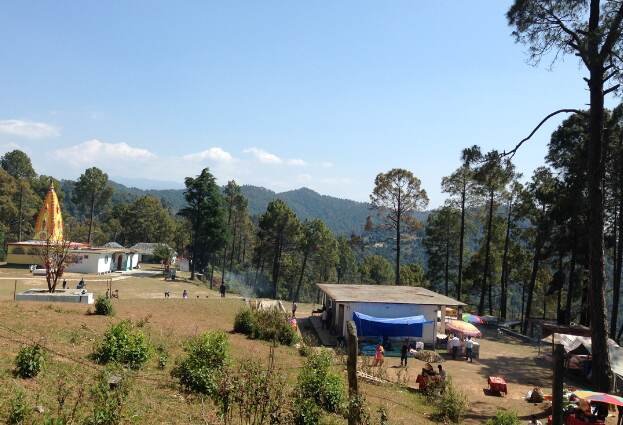
Over the centuries, the Dhuma Devi Temple has undergone numerous renovations and restorations, each contributing to its architectural and historical richness. The structure that stands today reflects a blend of traditional Himachali architecture with influences from various periods, showcasing intricate wood carvings and stone sculptures that narrate tales from Hindu mythology. The temple’s sanctum sanctorum houses the idol of Dhuma Devi, which is said to be self-manifested, further adding to its mystical allure.
Significant historical events have also marked the temple’s timeline. During the reign of Raja Joginder Sen in the 17th century, the temple gained prominence as a major center of worship and pilgrimage. It is recorded that the king made substantial contributions to the temple’s expansion and patronized various festivals and rituals that continue to be celebrated with great fervor to this day. Additionally, the temple has withstood the test of time, surviving natural calamities and political upheavals, a testament to its enduring significance in the region.
The Dhuma Devi Temple’s historical evolution mirrors the cultural and religious transformations of Himachal Pradesh. It remains a beacon of faith and devotion, drawing pilgrims and history enthusiasts alike. The temple not only preserves the spiritual legacy of Dhuma Devi but also offers a glimpse into the rich tapestry of Himachal Pradesh’s history, making it a vital landmark in the state’s heritage.
Religious Significance of Temple
The Dhuma Devi Temple in Mandi, Himachal Pradesh, holds profound religious significance for the local community and Hindu devotees alike. Nestled in the serene landscapes of the region, this temple is not merely a physical structure, but a spiritual epicenter that resonates deeply with the faithful. The temple is dedicated to Goddess Dhuma Devi, a revered deity in Hinduism, known for her protective and nurturing attributes, which draws scores of worshippers year-round.

For the local community, the Dhuma Devi Temple is a cornerstone of religious practice and cultural heritage. It serves as a gathering place where devotees partake in daily rituals, special pujas, and communal prayers. The temple’s rituals are meticulously observed, with priests performing traditional ceremonies that include offerings, chants, and hymns, creating an atmosphere imbued with devotion and reverence. These practices are not only acts of worship but also affirmations of the community’s collective faith and identity.
Festivals at Dhuma Devi Temple are vibrant and spiritually uplifting events. Major Hindu festivals like Navratri, Diwali, and Dussehra are celebrated with great enthusiasm. During these times, the temple comes alive with elaborate decorations, processions, and cultural performances, transforming it into a hub of religious fervor and joy. These festivals attract not only locals but also pilgrims from distant regions, underscoring the temple’s widespread influence and significance.
The Dhuma Devi Temple also plays a crucial role in the observance of lifecycle rituals. From birth ceremonies to weddings and even death rites, the temple stands as a witness to the pivotal moments in devotees’ lives. Its sacred grounds provide solace and blessings, reinforcing the spiritual connection between worshippers and the divine.
Local Festivals and Celebrations
The Dhuma Devi Temple in Mandi, Himachal Pradesh, is not only a revered place of worship but also a vibrant center of cultural and religious festivities. Throughout the year, the temple hosts numerous festivals and celebrations that draw both locals and visitors, creating an atmosphere of spiritual fervor and communal joy.
Navratri, a nine-day celebration honoring Goddess Durga, is a highlight. The temple transforms into a bustling center of faith and joy, adorned with colorful decorations and filled with the sounds of traditional music and dance. Daily pujas and spirited performances of Garba and Dandiya create an unforgettable atmosphere.
Another significant event is the annual Dhuma Devi Fair, marking the start of the agricultural season. This community gathering features religious rituals seeking divine blessings for a bountiful harvest. Beyond the spiritual aspects, the fair offers a vibrant showcase of local culture with folk dances, music, handicrafts, and delicious Himachali cuisine.
Diwali, the festival of lights, is celebrated with equal enthusiasm. The temple is bathed in a magical glow as thousands of lamps illuminate the night. Devotees gather to offer prayers for prosperity and well-being, creating a spiritually charged ambiance filled with devotional music and chants.
How to Reach Dhuma Devi Temple
Reaching the temple is relatively straightforward. Mandi is well-connected by road, and one can take a bus or hire a taxi from major cities like Chandigarh, Shimla, or Delhi. The nearest railway station is in Joginder Nagar, approximately 55 kilometers away, while the closest airport is the Kullu-Manali Airport at Bhuntar, around 75 kilometers from Mandi. From these points, local transport options are readily available to reach the temple.
The Dhuma Devi Temple is open to visitors from 6:00 AM to 8:00 PM daily. Entry is free, but donations are always appreciated as they contribute to the temple’s maintenance and community services. Visitors are advised to dress modestly, covering shoulders and knees, as a mark of respect for the sacred site. Footwear should be removed before entering the temple premises, and it is customary to wash hands and feet at designated areas.
Photography inside the temple may be restricted, so it is advisable to seek permission from the temple authorities. Additionally, maintaining silence and refraining from loud conversations will help preserve the sanctity of the environment. Visitors should also be mindful of the local customs and traditions, showing reverence to the deities and the temple’s heritage.
Best Time to Visit
Visiting the Dhuma Devi Temple in Mandi, Himachal Pradesh, offers a unique opportunity to immerse oneself in the spiritual and cultural heritage of the region. For travelers planning a visit, it is essential to consider several practical aspects to ensure a smooth and enjoyable experience.
The best time to visit the Dhuma Devi Temple is during the spring (March to May) and autumn (September to November) seasons. During these periods, the weather is pleasant, making the journey and exploration comfortable. The monsoon season (June to August) should be avoided due to heavy rains and potential landslides, which could pose travel challenges.
Best Nearby Places to Visit
Mandi, Himachal Pradesh, offers a plethora of attractions that complement the serene and spiritual experience at the Dhuma Devi Temple. Visitors can explore a range of natural sites, historical landmarks, and cultural experiences, making their trip to this region truly memorable.
Rewalsar lake
One of the must-visit sites is the Rewalsar Lake, located around 25 kilometers from Mandi. This picturesque lake is revered in Buddhism, Hinduism, and Sikhism, and is surrounded by a scenic landscape that includes lush hills and vibrant flora. The lake is also known for its floating reed islands and a variety of fish, making it a tranquil spot for reflection and relaxation.
Bhootnath Temple
For those interested in historical landmarks, the Bhutnath Temple in Mandi town should not be missed. Dedicated to Lord Shiva, this ancient temple dates back to the 16th century and showcases the intricate Himachali architecture. The temple complex often hosts cultural events and fairs, providing visitors with a glimpse into the local traditions and customs.
Prasher lake
Nature enthusiasts will find solace in Prashar Lake, situated about 49 kilometers from Mandi. Nestled in the Dhauladhar range, this lake is surrounded by a panoramic view of snow-capped mountains. The serene waters of Prashar Lake, along with the nearby Prashar Temple, offer a peaceful retreat for trekkers and nature lovers alike.
Bir Billing Valley
Another notable attraction is the Bir Billing Valley, which is known for its scenic beauty and outdoor activities. Visitors can enjoy a ride on the historic Joginder Nagar-Pathankot narrow-gauge railway, or explore the various trekking trails leading to breathtaking viewpoints.
Victoria Bridge
Lastly, the Victoria Bridge in Mandi town is a significant historical site. Built during the British era, this suspension bridge spans the Beas River and provides a picturesque view of the surrounding landscape. It’s a perfect spot for photography enthusiasts and those looking to appreciate the architectural heritage of the region.
Where is Dhuma Devi Temple Located?
The temple is located at Mandi Himachal Pradesh.
What are three main festivals celebrated in Dhuma Devi Temple?
Major Hindu festivals like Navratri, Diwali, and Dussehra are celebrated with great enthusiasm.
When does temple gained its prominence?
During the reign of Raja Joginder Sen in the 17th century, the temple gained prominence as a major center of worship and pilgrimage.
Who is the main deity of Dhuma Devi Temple?
The main deity of the temple is a black stone idol of Goddess Dhumavati
What is the best time to visit Dhuma Devi Temple?
The best time to visit the Dhuma Devi Temple is during the spring (March to May) and autumn (September to November) seasons. During these periods, the weather is pleasant, making the journey and exploration comfortable. The monsoon season (June to August) should be avoided due to heavy rains and potential landslides, which could pose travel challenges.
